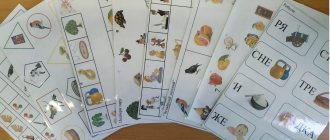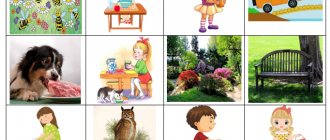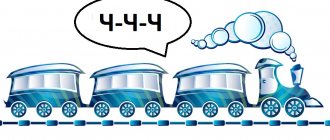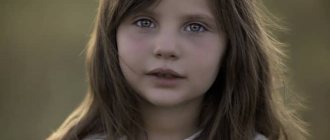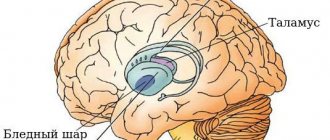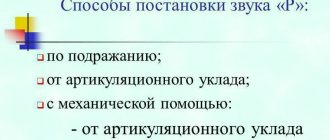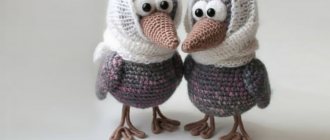Summary of a speech therapy lesson on the topic “Automation of sound [Ш] in syllables and words”
Subject:
Automation of the sound “Ш” in syllables and words.
Correctional educational tasks:
consolidate articulation and isolated pronunciation of the sound [w], continue to teach how to correctly pronounce the sound [sh] in syllables and words, learn to determine the presence of sound in words, practice the formation of diminutive nouns. agreeing nouns with numerals, dividing words into syllables.
Corrective and developmental tasks:
develop articulatory and fine motor skills, phonemic processes, breathing, attention. Memory and thinking.
Correctional and educational tasks:
cultivate cognitive interest in speech therapy classes. Positive emotional attitude to class, need for verbal communication.
Equipment:
Zvukoeshka doll, cards for characterizing the sound [w], “fizzies”; pictures on sound automation [sh], in words; didactic aids: “Speech therapy beads”, “Flowers and vases”, “Sun”, clothespins, ball.
1. Organizational moment
Speech therapist:
Hello, today we will continue to learn to speak clearly and beautifully. Let's warm up a little.
Development of general motor skills.
The naughty mice are dancing,
Some are on the cup, some are on the lid (dancing)
Hush, hush, hush, mice.
Don't disturb your little brother's sleep (walks on tiptoes)
Breathing exercise.
In order for us to do well, we will do breathing exercises. Let's take a deep breath through our nose and breathe in beauty, kindness and health, and exhale through our mouth all the grievances and sorrows. Remember: we don’t puff out our cheeks, we don’t raise our shoulders.
We inhale and exhale three times.
To be attentive and diligent, we will give you a massage.
Self-massage of the face.
Rubbing the hands (rubbing palms)
And warm up (claps)
And we wash our face with our warmth (run warm palms over the face from top to bottom)
Rake rakes away all bad thoughts (rake-like movements with fingers from the middle of the forehead to the temples).
We rub the ears up and down quickly (rubbing the ears along the edges from bottom to top and top to bottom).
We bend them forward, pull them by the lobes (bending the ears in front and pulling down by the lobes).
And then we move our fingers to the cheeks (fingers run to the cheeks)
We knead the cheeks so that they puff up (the thumb, index and middle fingers knead the cheeks in a circular motion).
We knead our lips so that we smile (the thumb and index finger knead first the lower and then the upper lip).
We lift the cheeks with the corners of our lips (raise the cheeks at the corners of our lips with our index fingers).
And then we flow from the nose to the lips (movements from the nose to the lips downwards).
We pull the chin and pinch the ears
And then we run it down the neck with our hands.
To speak clearly and beautifully, let's do some exercises for the tongue.
Remember our rule?
The eyes look and see everything,
Ears listen and hear everything,
The head thinks, and the hands help.
2. Articulation gymnastics
- We close our teeth evenly, and we get a “fence” (at the same time we connect our hands in a horizontal position),
- We smoothly rounded the lips, we depicted a “donut” (at the same time round the palms and connect them together).
Alternating the first and second exercises.
- Place your tongue with a “spatula” and hold it a little (keep your palm horizontal).
- I hold the nut on my cheek, you can’t bite it - it’s so hard
- (the left hand is straightened vertically, the right hand is clenched into a fist and rests against the left hand, then vice versa).
- Raise your tongue up and then lower it. So keep swinging... (movements with palms down and up are performed synchronously).
- Place your tongue wide, and lift the edges, turning it into a “cup” (palms take the shape of a cup).
- Take a ride with your horse and learn to click loudly. (the index finger and thumb perform movements imitating a running horse on the table)
3. Report the topic of the lesson.
A doll is brought in.
- This is Zvukoeshka. (the sound [sh] is pronounced accented)
What sound did I highlight in my voice? (sound [sh]) Today is Zvukoeshka’s birthday. We will visit her at the holiday and will continue to learn how to pronounce the sound [w] correctly.
4. Characteristics of the sound [sh] according to articulatory and acoustic characteristics.
Let's tell Zvukoshka how we pronounce the sound [w].
— When we pronounce the sound [w], in what position are our lips: rounded or stretched in a smile? (child chooses the correct card).
— Where is the tongue located: at the top or bottom?
— What shape does the tongue take: cups or spatulas?
- What sound [sh]: whistling or hissing?
- Is the sound [sh] ringing or dull?
-Is the sound [sh] a vowel or a consonant?
- Which Sounder will we designate the sound “Ш”: blue, red or green?
5. Development of phonemic hearing.
The sound girl invites you to catch the sound [sh]. This hour I will name a series of sounds, syllables and words, and when you hear the sound [w], clench your palms into fists.
Sounds:
S, X, W, Ch, Shch, F, Sh, S, X, Sh.
Syllables:
HA, SU, SHA, ZHA, FU, SHA, HO, SHO, SHI.
Words:
HUT, SOUP, TIRE, FOCUS, HAT, LEATHER, PUPPY, CANNON.
Well done, you hear the sound [sh] well, and now Zvukoeshka wants to hear how you pronounce the sound [sh].
6. Isolated pronunciation of the sound [sh].
Look at these pictures. Hiss like a snake, like an angry cat, like oil in a hot frying pan.
Zvukoeshka liked the way you pronounce the sound [w], she gives you a photo of the sound [sh] - the letter “Sh”.
7. Pronunciation of the sound [w] in syllables.
Let's make friends of the letter “Ш” with vowels. Name them. (A, O, U, I, E, Y) Collect the sun and read the syllables. (direct and reverse).
Didactic exercise “Fingers say hello”»
(all fingers touch the thumb in turn while simultaneously pronouncing the syllable “SHA” (on the right hand), “SHU” (on the left hand)
Didactic exercise "Su-Jok".
Rolling the massager over the palm while simultaneously pronouncing the reverse syllables “ASH”, “OSH”, “USH”, “ISH”, “ESH”
8. Pronunciation of the sound “Ш” in syllables and words.
Didactic game “Catch the ball, say the word.”
(Physical minute)
- A syllable and a syllable will become a word,
We'll play the game again.
The speech therapist says a syllable and throws the ball to the child, the child comes up with a word with this syllable and throws the ball back.
- Remember our rule? The head thinks, and the hands help.
Now our hands will help us, and to make it easier for our fingers to work, let's do a massage.
9. Massage your fingers with the “Cheerful Kitten” clothespin.
The silly kitten bites hard,
He thinks it's not a finger, but a mouse,
But I'm playing with you, baby,
And if you bite, I’ll tell you: “Shoo.”
10. Automation of the sound “Ш” in words.
- Zvukoeshka is sad for some reason. It's her birthday today! Let's give her gifts.
Didactic exercise “Beads”».
The child strings “beads” on a cord, on which there are pictures with the sound “Ш” (2-3 pictures with other sounds), selects the necessary ones, clearly pronouncing the words.
Didactic exercise “Flowers and Vases”.
The child gives Zvukoeshka Flowers with pictures with the sound “Ш” pasted on them, places them in vases, determining the position of the sound “Ш” in the word (at the beginning, in the middle, at the end of the word)
Didactic exercise “Say kindly».
Let's call Zvukoeshka affectionately. (Zvukoeshechka) and give her pictures, which we will also call affectionately.
11. Summary
Well done, you tried very hard today, you pronounced the sound [sh] beautifully. Thank you for the lesson.
Used Books:
- Altukhova N.G. Learn to hear sounds. St. Petersburg: Publishing House "Lan", 1999.
- Volina V.V. ABC book holiday, M: AST-PRESS, 1995.
- Volina V.V. We learn by playing, M: New School, 1994.
- Komarova L.A. Automation of the sound “Ш” in game exercises. Preschooler's album. M: Publishing house "Gnome and D", 2007.
- Lopukhina I.S. Speech therapy. 550 entertaining exercises for speech development.
“Automation of the sound “Ш” in sentences.” (Individual lesson notes)
Objectives of the lesson: Reinforce the correct pronunciation of the sound sh in sentences; development of skills in phonemic analysis and synthesis, as well as sentence structure analysis; expanding the vocabulary with adjectives denoting quantity; consolidation in speech of the correct agreement of an adjective with a noun in gender, a common sentence with a definition.
Lesson content:
- Organizing time.
- Articulatory gymnastics and clarification of the articulation of the sound sh.
- "Spatula"
Place your tongue with a spatula
And hold it calmly.
- "Cup"
Put your tongue wide
And raise the edges.
- "Swing"
I swing on a swing.
Up, down, up, down.
- "Harmonic"
I play the harmonica
I open my mouth wider.
I'll press my tongue to the roof of my mouth,
I'll move my jaw lower.
When pronouncing the sound “Ш”, the lips are slightly rounded, the tongue, like a “cup”, rises up behind the upper teeth, air passes through the middle of the tongue, the voice “sleeps”.
- Add a word that has the opposite meaning to the sentence. The following offers are offered:
Speech therapist: The mouse is small, and the bear... (big).
The chamomile is small, and the tree... (big).
The closet is big, huh. ball... (small).
The foal is small, and the horse... (big).
The cow is big, and the cat... (small).
The bucket is big, and the bucket... (small).
Speech therapist: Remember in which words we hear the sound “Ш” (big, big, big)
Speech therapist: What words did you add? (Small big.)
Speech therapist: What question is answered by the words small, big! (To the question which one?)
Speech therapist: These words indicate the size of the object. Repeat.
- Determining the size of objects.
On the board there are pairs of pictures depicting objects of different sizes: a mug - a bucket, a ball - a car, a toy - a bag, a scarf - a coat, a cracker - a wardrobe, a brooch - a shirt, a pencil - a tree.
Speech therapist: Name the pairs of objects in the pictures. Which of these items is big and which is small? (The mug is small, but the bucket is large, etc.)
- Highlighting endings of adjectives.
Speech therapist: Select the items that we called large. (Bucket, car, bag, coat, wardrobe, shirt, tree.)
Speech therapist: Determine which words have the sound sh. What is the place of this sound in a word?
Speech therapist: Replace the names of the pictures with the words he, she or it.
Speech therapist: I will name the picture, and you name the word he, she or it.
Speech therapist: What words can be replaced with the word he! Name them. (Bag, closet.) Pictures are placed separately.
Speech therapist: What size bag? (Large.) And the closet? (Big.)
Speech therapist: What is the last sound in the word big? (th).
Speech therapist: What sound is heard before th? (O).
The ending -oi is written next to the pictures.
Speech therapist: Choose objects that can be called the word she. (Car, shirt.)
Speech therapist: What car? (Big.)
Speech therapist: What shirt? (Big.)
Speech therapist: What do you hear after w? Name the sounds of the word after sh (th).
The letters -aya are written next to the pictures.
Speech therapist: Choose pictures that can be called the word it. (Bucket, tree.)
Speech therapist: What kind of bucket? (Big.)
Speech therapist: What kind of tree? (Big.)
Speech therapist: What do you hear at the end of a word after w? (s).
The letters -ое are written next to the pictures.
Speech therapist: Name the objects that we called small. (Small mug, etc.)
- Add the words big or small to the sentence.
Speech therapist: A mouse rustles in the corner. Add what kind of mouse (small).
Grandfather built a hut. (Which?)
Schoolchildren decorated the Christmas tree.
We are studying in school.
The cat gave birth to kittens.
Grandma baked cheesecake.
- Proposal analysis. Drawing up a graphical diagram of the proposal. Highlighting words with the sound sh.
Grandmother baked a large cheesecake.
|________________ ======== ~~~~~~~~ ________________ .
Speech therapist: How many words are in a sentence? (Four)
Speech therapist: What is the first word?
Speech therapist: What diagram will we use to denote the first word? Etc.
Speech therapist: Which letter should we start writing the sentence with?
Speech therapist: What do we put at the end of the sentence?
Speech therapist: Name words with the sound “SH”.
- Summing up the lesson.
